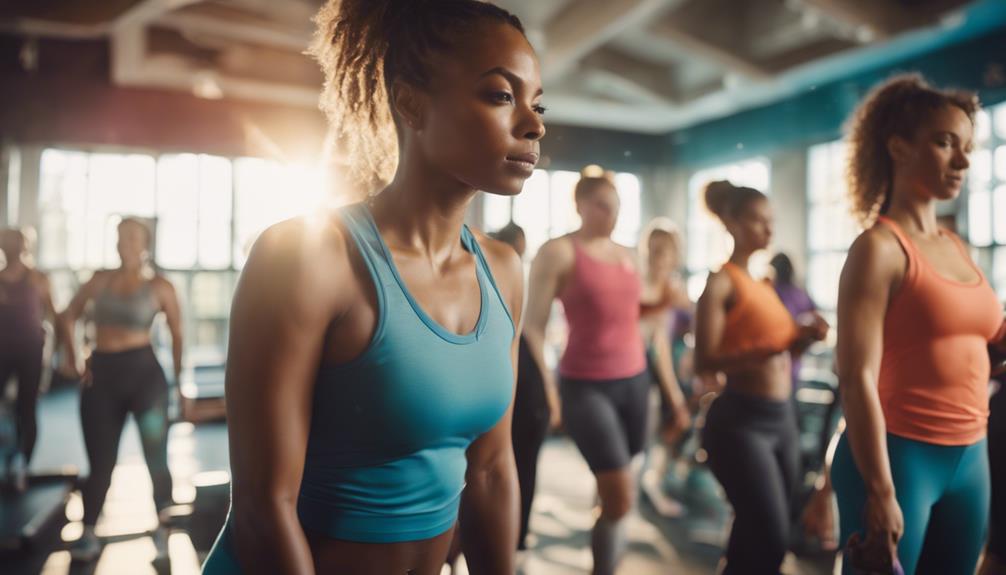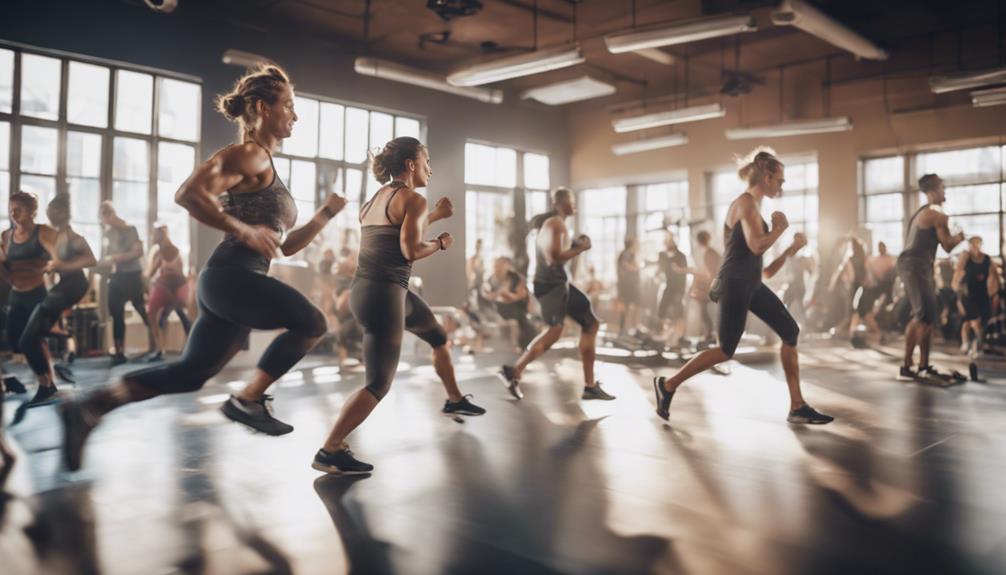To effectively reduce cellulite, combine aerobic exercises, strength training, and healthy lifestyle choices. Try to get in at least 200 minutes of moderate aerobic activity each week, such as running or cycling, to help with fat loss. Make sure to include 2-3 strength training sessions per week, focusing on exercises like lunges and glute bridges to tone your muscles. Don’t underestimate the benefits of High-Intensity Interval Training (HIIT) to increase your metabolism. Maintain a balanced diet, emphasizing high-fiber foods, hydration, and lean proteins for optimal results. Stay consistent and you will see progress. Keep an eye out for more tips on how to maximize your efforts!
Key Takeaways
- Engage in at least 200 minutes of moderate-intensity aerobic exercises weekly to enhance fat loss and improve skin appearance.
- Incorporate strength training exercises like lunges and glute bridges 2-3 times a week to tone muscles and firm skin.
- Utilize High-Intensity Interval Training (HIIT) to boost metabolism and maximize calorie burn, aiding in cellulite reduction.
- Maintain a balanced diet rich in fruits, vegetables, and lean proteins while hydrating with at least 64 ounces of water daily.
Understanding Cellulite

Cellulite, often seen as dimpled skin on your thighs and buttocks, affects about 85% of women over 20, making it a common concern. This dimpled appearance occurs when fat deposits push through the connective tissue beneath your skin.
While you may associate cellulite with body fat, it's important to understand that the presence of cellulite can happen regardless of your weight. Genetics, age, and hormonal changes play vital roles in its development.
To reduce the appearance of cellulite, you can adopt a multifaceted approach. Regular exercise is essential, as it helps maintain a healthy body fat percentage and supports weight loss.
Strength training can tighten muscles and improve skin tone but won't target cellulite directly. Instead, focus on incorporating aerobic activities alongside a healthy diet rich in fruits, vegetables, and lean proteins. Staying hydrated also plays a key role in skin health.
While there's no magic solution to completely eliminate cellulite, consistent exercise and healthy lifestyle choices can greatly improve its appearance over time.
Effective Aerobic Exercises

To effectively combat the appearance of cellulite, incorporating a range of aerobic exercises into your routine can greatly enhance fat loss and improve skin tone. Engaging in aerobic exercise like walking, running, cycling, or swimming increases your heart and breathing rates, helping you burn calories and ultimately reduce cellulite visibility.
High-intensity interval training (HIIT) is particularly beneficial; it boosts your metabolism and promotes fat release from problem areas. By alternating between high-intensity bursts and recovery periods, you'll keep your body in a calorie-burning mode long after your workout.
Aim for at least 200 minutes of moderate-intensity aerobic activity each week. This commitment can greatly contribute to your overall fat loss efforts, which are essential to minimizing the appearance of cellulite.
Don't forget to mix up your exercises to keep things interesting and reduce the risk of injury. Try various activities like dancing, kickboxing, or even group classes to stay motivated.
The more you enjoy your workouts, the more likely you'll stick with them, leading to effective exercises to get rid of stubborn cellulite. Start today, and watch your skin tone improve!
Strength Training for Cellulite

To tackle cellulite effectively, you need to focus on targeted strength exercises like curtsy lunges and glute bridges.
Aim for 2-3 sessions each week, consistently working through sets of 10-20 repetitions to build muscle tone.
Targeted Strength Exercises
Targeted strength exercises, like curtsy lunges and glute bridges, can greatly enhance muscle tone and reduce the visibility of cellulite when performed consistently. Incorporating a variety of exercises not only targets the glutes but also improves overall body composition, leading to effective cellulite reduction.
Here are three key exercises to include in your routine:
- Lateral Lunges: These specifically target the glutes, quads, and hamstrings. Aim for 12 reps on each side to enhance muscle tone and reduce the appearance of cellulite.
- Step-Ups with Reverse Lunges: This engagement of multiple muscle groups, focusing on the glutes and hamstrings, should be executed with 3 sets of 10 reps for ideal results.
- Glute Bridges: A fantastic way to strengthen your glutes, they can be done anywhere and should be included in your weekly routine.
Frequency and Consistency
Regularly incorporating strength training into your routine is essential for effectively reducing the appearance of cellulite. Aim to perform targeted exercises like curtsy lunges and glute bridges 2-3 times a week. Consistency in your workouts is key; aim for 3 sets of 10-15 repetitions for each exercise. This approach not only enhances muscle tone but also improves skin appearance.
Mixing in a variety of strength exercises, such as lateral lunges and step-ups, will engage different muscle groups and promote overall body improvement. By doing so, you'll keep your workouts fresh and challenging, ensuring you stay committed.
Don't forget to combine strength training with aerobic exercises to maximize calorie burning and fat loss. This combination greatly boosts your efforts in cellulite reduction. Regularly assess your progress to see what's working and adjust your routine as needed to keep it effective.
With dedication and a well-structured plan, you can transform your body and reduce the visibility of cellulite. So, stick to your schedule, and you'll be well on your way to achieving your goals!
High-Intensity Interval Training

High-Intensity Interval Training (HIIT) effectively boosts your metabolism and helps reduce the appearance of cellulite by promoting significant fat loss in affected areas. This workout method elevates your heart rate, leading to impressive calorie burn and lasting effects even after you're done exercising.
To maximize your results, consider these three key elements of HIIT:
- Incorporate Variety: Mix exercises like interval running and circuit training to enhance mechanical stimulation and target different muscle groups.
- Maintain Consistency: Stick to a regular HIIT schedule, combining it with other strength and aerobic workouts to see visible improvements in skin firmness over time.
- Focus on Recovery: Allow your body to recover adequately between sessions to sustain performance and prevent injury, ensuring you stay committed to your routine.
Nutritional Tips for Reduction

Incorporating a variety of nutrient-dense foods into your diet can greatly enhance your efforts to reduce the appearance of cellulite. Start by including high-fiber foods like fruits and vegetables, which promote satiety and support weight loss.
Staying properly hydrated is equally important; aim for at least 64 ounces of water daily to aid in waste elimination and improve skin elasticity, making cellulite less noticeable.
Be mindful of your sugar intake. Reducing sugar and avoiding processed foods can help lower your body mass index (BMI), which is beneficial for managing cellulite. Focus on consuming lean proteins and healthy fats, as these nutrients support muscle development and improve overall body composition.
Don't underestimate the power of regular vegetable juicing. It provides essential nutrients that further support skin health and elasticity, complementing your exercise efforts.
Common Myths Debunked

You might believe targeted exercises can eliminate cellulite, but that's a common misconception.
Many popular workouts, like squats and hip bridges, won't greatly reduce its appearance.
Let's clear up the misinformation floating around in the media and focus on what really works for effective cellulite management.
Spot Reduction Myth
Debunking the spot reduction myth reveals that targeted exercises won't effectively eliminate cellulite, as fat loss occurs throughout the body rather than in isolated areas.
While you might see claims that specific workouts can banish cellulite, it's crucial to recognize the reality of exercise effectiveness.
Here are three key points to reflect upon:
- Fat Loss is Global: You can't choose where your body sheds fat. A holistic approach to fitness is necessary for overall fat reduction.
- Muscle Tone Matters: While targeted exercises can improve muscle tone, they don't specifically target cellulite because it's influenced by genetics and overall body fat.
- Exercise Types: Common leg exercises like plié squats and hip bridges have shown minimal impact on cellulite appearance, highlighting their limitations.
Instead of relying solely on targeted exercises, focus on a balanced workout routine that promotes overall fat loss and enhances skin firmness.
By understanding the nature of cellulite and the myths surrounding spot reduction, you can create a more effective fitness plan tailored to your goals.
Embrace a holistic approach for the best results!
Exercise Misconceptions
Understanding exercise misconceptions is vital for making informed choices about fitness routines and managing expectations regarding cellulite.
One common myth is that spot reduction through targeted exercises can eliminate cellulite. Unfortunately, scientific studies confirm this isn't true; fat can't be selectively targeted through specific workouts. While you might think that focusing on leg exercises like plié squats or hip bridges will help, these have shown no significant impact on reducing the appearance of cellulite.
Many fitness recommendations you find online often exploit these misconceptions, promoting ineffective exercises for financial gain rather than providing evidence-based solutions. It's important to recognize that just because a workout is popular doesn't mean it works for cellulite. Additionally, despite claims, specific yoga poses won't eliminate cellulite, either.
Instead, adopting a holistic approach to fitness can yield better results. A varied fitness program that includes strength training, cardiovascular exercise, and flexibility work is vital for improving skin firmness overall.
Focus on well-rounded workouts and healthy lifestyle choices to effectively manage cellulite instead of falling for misleading exercise misconceptions.
Misinformation in Media
Misinformation in media often leads people to believe that specific exercises can completely eliminate cellulite, but the reality is far more complicated. Common myths, fueled by fitness publications and online sources, can mislead you about effective treatments. Here are three misconceptions you should be aware of:
- Targeted Exercises Don't Work: You can't spot reduce fat or cellulite. Exercises like plié squats and hip bridges won't specifically eliminate cellulite.
- Not All Media Is Reliable: Many YouTube videos promote targeted exercises for cellulite reduction without scientific backing. These claims often exploit misconceptions for financial gain.
- Holistic Approach Matters: Effective cellulite reduction involves a combination of proper nutrition and varied exercise routines. Relying solely on targeted exercises won't yield the results you want.
To truly manage the appearance of cellulite, focus on a holistic approach that integrates balanced nutrition and a thorough fitness regime.
Lifestyle Changes to Consider

Making simple lifestyle changes can greatly impact the appearance of cellulite and enhance your overall skin health.
Start by incorporating regular aerobic exercises, like walking or cycling, to help reduce fat and promote weight loss. Aim for at least 150 minutes of moderate-intensity workouts each week.
Additionally, include strength training exercises such as squats and lunges 2-3 times a week to improve muscle tone and boost skin firmness, which can diminish the visibility of cellulite.
Focus on a balanced diet rich in fruits, vegetables, and lean proteins while minimizing sugary snacks and fatty foods. This approach supports overall health and aids in weight management, further contributing to reduced cellulite.
Hydration is essential, too. Aim to drink at least 64 ounces of water daily to maintain skin elasticity and prevent weight gain, which can worsen cellulite's appearance.
Implementing these lifestyle changes, like regular physical activity and mindful eating, can lead to gradual weight loss of 1-2 pounds per week, improving skin elasticity and reducing the visibility of cellulite over time.
Start today, and watch your skin health transform!
Professional Treatment Options

If you're looking for effective ways to tackle cellulite, professional treatment options can be a game-changer.
Non-invasive techniques, like advanced radiofrequency and ultrasound cavitation, can enhance skin firmness while minimizing the appearance of cellulite.
These treatments work well alongside your exercise and diet, giving you a thorough approach to cellulite management.
Non-Invasive Techniques
Non-invasive techniques for cellulite reduction offer effective professional treatment options that can enhance your skin's appearance without the need for surgery. These methods can greatly improve the texture and firmness of your skin while fitting seamlessly into your lifestyle.
Here are three popular non-invasive techniques you might consider:
- Radiofrequency Therapy: This treatment stimulates collagen production and improves skin elasticity, delivering noticeable results without downtime.
- Ultrasound Cavitation: It targets fat cells beneath the skin to reduce the appearance of cellulite. This method boasts a high safety record and minimal recovery time.
- Laser Therapy: Often used in combination with other treatments, this method employs focused light energy to break down fat and enhance skin texture, usually requiring several sessions for the best results.
Additionally, incorporating professional-grade cellulite creams can amplify the effects of these treatments, especially when paired with regular exercise.
Many clinics offer personalized treatment plans to guarantee you receive tailored care that addresses your specific needs and goals. By exploring these options, you can take confident steps toward smoother, firmer skin.
Advanced Technology Solutions
Exploring advanced technology solutions for cellulite treatment can greatly enhance the results of your existing regimen, providing you with cutting-edge options that effectively target the root causes of cellulite. With advanced technologies like radiofrequency and ultrasound cavitation, you can experience effective skin tightening and cellulite reduction with a safety record exceeding 99.5%.
These professional treatments complement your exercise efforts, leading to firmer skin and improved satisfaction. LipoTherapeia utilizes state-of-the-art techniques to boost collagen production, ensuring peak results.
Here's a quick comparison of treatment options:
| Treatment Type | Benefits | Recommended For |
|---|---|---|
| Radiofrequency | Skin tightening, non-invasive | Mild to moderate cellulite |
| Ultrasound Cavitation | Fat breakdown, safe | Moderate cellulite |
| LipoTherapeia | Collagen boost, targeted | Severe cellulite |
Regular assessments by healthcare professionals are essential in maximizing your treatment plans, ensuring they cater to your individual needs. Investing in these advanced treatments can accelerate your journey toward smoother skin and improved confidence. Don't hesitate to consult with a specialist for tailored solutions!
Importance of Consistency

Why is consistency so vital in your workout routine for reducing cellulite? Consistent exercise is the key to seeing real results in the battle against cellulite. It may take several weeks of dedicated effort before you notice visible changes in your skin's appearance.
If you want to effectively reduce cellulite, here are three important components to include in your routine:
- Aerobic Activity: Aim for at least 150 minutes of moderate aerobic exercise each week. This helps improve circulation and aids in fat loss, both of which can diminish the appearance of cellulite.
- Strength Training: Incorporate strength training 2-3 times per week. Building muscle not only tones your body but also enhances skin firmness, making cellulite less noticeable.
- Variety: Engage in a varied fitness program. Mixing up your workouts keeps things interesting and guarantees you're targeting different muscle groups, which can further aid in reducing cellulite.
When you commit to this consistent exercise routine, you'll experience not only improvements in your cellulite but also overall body composition and health.
Stick with it, and the results will come!
Tracking Your Progress

Tracking your progress is essential for understanding how effective your workout routine is in reducing the appearance of cellulite over time. Consistent tracking helps you identify what's working and what needs adjustment. Start by regularly measuring your body circumference, focusing on areas like your thighs and hips. These measurements give you quantifiable data to monitor fat loss and muscle tone improvements, which are vital in managing cellulite.
Keep a workout journal to log your exercises, duration, and intensity. This not only holds you accountable but also keeps you motivated as you see your efforts translate into results. Additionally, don't forget to document your dietary changes and hydration levels alongside your exercise routine. A holistic view of your lifestyle adjustments can reveal how they impact the visibility of cellulite.
Consider taking progress photos at consistent intervals. These visuals can illustrate changes in skin texture and firmness, reinforcing your commitment to your fitness regimen. By tracking your progress in these ways, you'll empower yourself to make informed decisions, maximizing the effectiveness of your efforts against cellulite.
Frequently Asked Questions
Can You Really Get Rid of Cellulite With Exercise?
You can't completely get rid of cellulite with exercise alone, but incorporating strength training and aerobic activities can improve skin firmness, enhance muscle tone, and ultimately reduce its appearance over time with consistency and a healthy diet.
Will Cellulite Go Away if I Tone My Legs?
Did you know that over 90% of women experience cellulite? Toning your legs can improve muscle definition and skin appearance, but it won't completely eliminate cellulite. Focus on overall fat reduction and consistency for better results.
How to Reduce Cellulite in 2 Weeks?
To reduce cellulite in 2 weeks, combine HIIT workouts with strength training, hydrate well, and eat high-fiber foods. Track your progress regularly to see visible results and stay motivated throughout your journey.
Can You Realistically Get Rid of Cellulite?
You can't completely get rid of cellulite, but you can minimize its appearance. By incorporating strength training, aerobic exercises, and maintaining a healthy lifestyle, you'll notice improvements in skin elasticity and muscle tone over time.
Can the Effective Workout for Cellulite also Help Reduce Armpit Fat?
Say goodbye to armpit fat by incorporating effective workouts for cellulite. Activities like strength training, cardio, and high-intensity interval training can help reduce both cellulite and armpit fat. Targeting the triceps and surrounding muscles can lead to a more toned and defined upper body.
Conclusion
Now that you're armed with these powerful strategies, it's time to take action.
Imagine stepping into your favorite outfit, feeling confident and cellulite-free.
But remember, the journey doesn't end here. Consistency is key, and the results you crave are just around the corner.
Are you ready to embrace this transformation?
Each step you take brings you closer, so don't wait.
Immerse yourself in your new routine today, and watch as those stubborn dimples begin to fade away!










